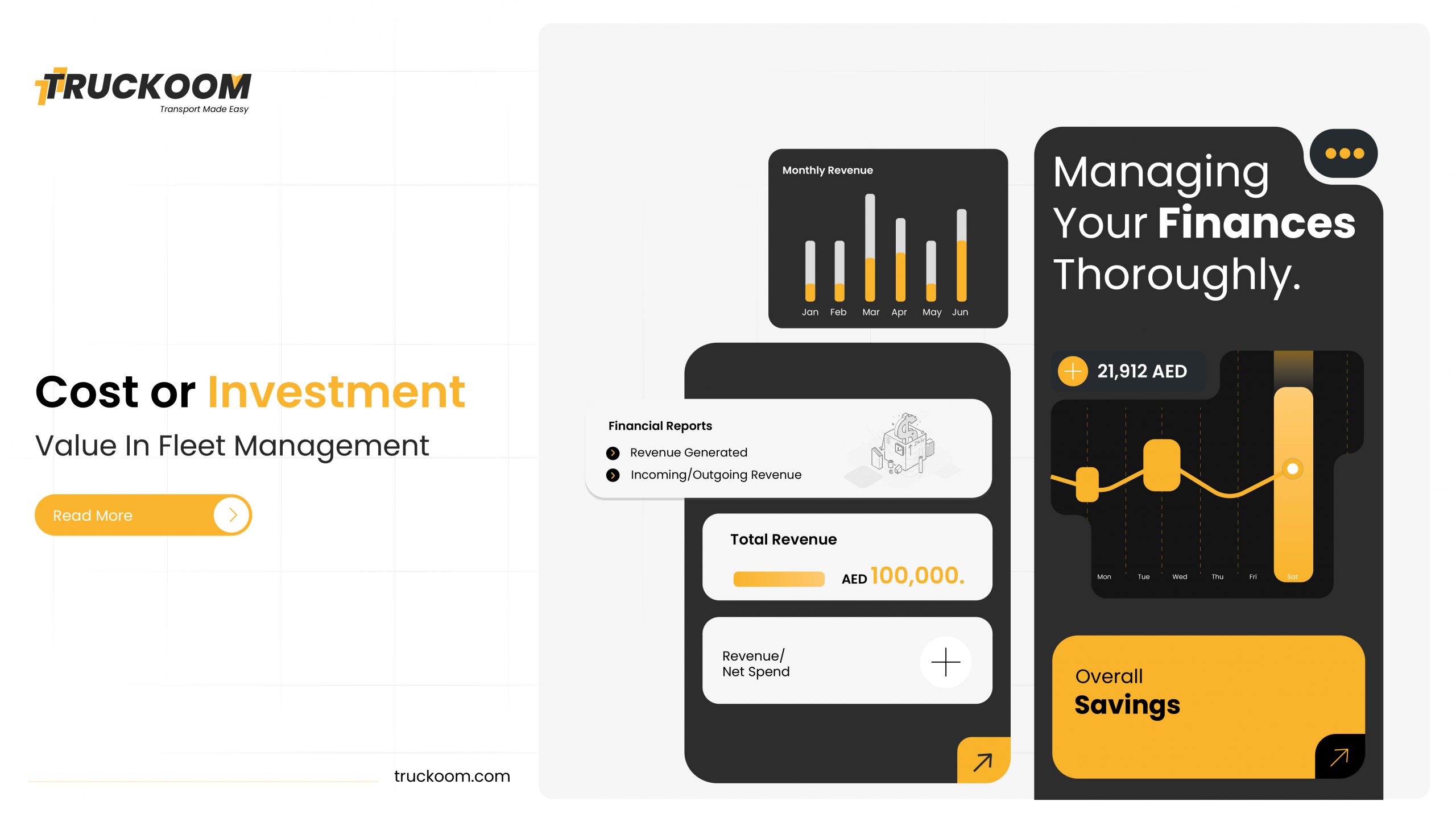Fleet management is a vital part of any business that relies on transportation. It involves evaluating and coordinating the use of a company’s vehicles, including cars, trucks, and other vehicles used for business purposes. Effective fleet management can result in increased efficiency, improved safety, and reduced costs for businesses.
In this blog post, we will discuss the return on investment (ROI) of fleet management and how to calculate the value of your investment.
What is Fleet Management?
Fleet management is the process of overseeing, organizing, and optimizing the use of a company’s fleet of vehicles. It involves everything from vehicle acquisition and maintenance to driver safety and fuel management. The goal of fleet management is to improve the efficiency, safety, and productivity of a company’s vehicle fleet while reducing costs.
Fleet management can include a wide range of activities, including:
- Vehicle acquisition and disposal
- Vehicle maintenance and repair
- Fuel management
- Driver safety training
- Route planning and optimization
- Asset tracking and management
- Compliance with government regulations
Why is Fleet Management Important?
Fleet management is essential for businesses that rely on transportation to operate. By optimizing the use of vehicles and ensuring they are maintained properly, businesses can achieve several benefits, including:
Improved Efficiency
By optimizing routes and reducing idle time, fleet management can improve the efficiency of a company’s vehicles, resulting in reduced fuel consumption and increased productivity.
Enhanced Safety
Fleet management can help businesses identify and address safety risks, resulting in fewer accidents and lower liability costs.
Reduced Costs
By properly maintaining vehicles and optimizing routes, fleet management can reduce maintenance costs and fuel consumption, resulting in lower operating costs.
Better Customer Service
By ensuring that vehicles are correctly maintained and that drivers are trained to provide excellent customer service, fleet management can help businesses improve customer satisfaction and retention.
Calculating the ROI of Fleet Management
Now that we understand the cost associated with fleet management, we can calculate the ROI. The ROI formula is:
ROI = (Net Profit / Cost of Investment) x 100%
Net profit is the amount of money a company makes after deducting all expenses. The cost of investment is the total cost of operating the fleet.
For example, if a company spends $500,000 on fleet management and makes a net profit of $750,000, the ROI would be:
ROI = ($750,000 / $500,000) x 100%
ROI = 150%
A positive ROI means that the investment in fleet management is profitable, and the company is generating more revenue than it’s spending on fleet management.
Calculating the ROI of fleet management can be challenging because it involves a range of factors that can impact a company’s bottom line. However, there are several key metrics that businesses can use to measure the value of their investment in fleet management.
Fuel Consumption
Fuel consumption is one of the most significant costs associated with operating a fleet of vehicles. By optimizing routes, reducing idle time, and promoting fuel-efficient driving habits, fleet management can help businesses reduce fuel consumption and lower costs.
Tracks by Truckoom is a powerful, cost-effective software that is useful for businesses of any size. Truckoom uses data collected from each vehicle in a fleet to provide drivers with enhanced insights into the business operation. They can see which routes and driving habits are most efficient, allowing them to fine-tune processes and save money on fuel consumption by meeting their transportation requirements more effectively.
This optimization adds value straight to the bottom line by reducing mileage traveled for every job completed – adding value directly to the income statement. Truckoom puts access to efficient fleet management at your fingertips so you can operate an organization more profitably with ease.
To calculate the ROI of fuel management, businesses can compare their fuel consumption before and after implementing fleet management strategies. For example, if a company’s fuel consumption decreases by 10% after implementing fleet management, it can calculate the ROI by dividing the cost of implementing fleet management by the savings in fuel costs.
Maintenance Costs
Proper vehicle maintenance is essential for ensuring that vehicles operate safely and efficiently. By implementing a proactive maintenance program that includes regular inspections, repairs, and replacements, fleet management can help businesses reduce maintenance costs and extend the life of their vehicles.
To calculate the ROI of maintenance management, businesses can compare their maintenance costs before and after implementing fleet management strategies. For example, if a company’s maintenance costs decrease by 20% after implementing fleet management, it can calculate the ROI by dividing the cost of implementing fleet management by the savings in maintenance costs.
Driver Safety
Driver safety is a critical component of fleet management. By providing driver safety training and implementing safety policies and procedures, businesses can reduce the risk of accidents and lower liability costs.
To calculate the ROI of driver safety, businesses can compare their accident rates before and after implementing fleet management strategies. For example, if a company’s accident rates decrease by 30% after implementing fleet management, they can calculate the ROI by dividing the cost of implementing fleet management by the savings in accident-related expenses, such as insurance premiums and vehicle repairs.
Productivity
Improving productivity is one of the most significant benefits of fleet management. By optimizing routes and reducing idle time, businesses can increase the number of deliveries or services they provide each day, resulting in increased revenue.
To calculate the ROI of productivity, businesses can compare their productivity before and after implementing fleet management strategies. For example, if a company can complete 20% more deliveries each day after implementing fleet management, it can calculate the ROI by dividing the cost of implementing fleet management by the increase in revenue generated by the additional deliveries.
Compliance
Compliance with government regulations is essential for businesses that operate commercial vehicles. By implementing a compliance program that ensures drivers and vehicles comply with regulations such as hours of service and vehicle maintenance requirements, businesses can avoid costly fines and penalties.
To calculate the ROI of compliance management, businesses can compare their compliance-related costs before and after implementing fleet management strategies. For example, if a company’s compliance-related costs decrease by 15% after implementing fleet management, it can calculate the ROI by dividing the cost of implementing fleet management by the savings in compliance-related costs.
Benefits of Fleet Management
Fleet management can bring several benefits to a company, which can increase the ROI. Here are some benefits of fleet management:
Improved Vehicle Maintenance
Regular maintenance and repairs can reduce the risk of breakdowns and increase the lifespan of vehicles. This can save companies money on repair costs and reduce the downtime of vehicles, resulting in increased productivity.
Reduced Fuel Consumption
Fleet management systems can optimize routes and reduce idle time, resulting in reduced fuel consumption. This can save companies money on fuel costs and reduce their carbon footprint.
Increased Driver Safety
Fleet management systems can monitor driver behavior, such as speeding and harsh braking, and provide feedback to drivers. This can reduce the risk of accidents and improve driver safety, resulting in lower insurance premiums and reduced liability costs.
Improved Customer Service
Fleet management systems can provide real-time tracking of vehicles, allowing companies to provide accurate delivery times to customers. This can improve customer satisfaction and increase repeat business.
Increased Efficiency
Fleet management systems can automate processes, such as dispatching and scheduling, resulting in increased efficiency and reduced administrative costs.
Conclusion
Fleet management is a critical component of any business that relies on transportation to operate. By optimizing the use of vehicles, improving safety, and reducing costs, fleet management can provide significant benefits to businesses. Calculating the ROI of fleet management can be challenging, but by focusing on key metrics such as fuel consumption, maintenance costs, driver safety, productivity, and compliance, businesses can measure the value of their investment in fleet management.
Overall, fleet management can bring several benefits to a company, which can increase the ROI and improve the bottom line




